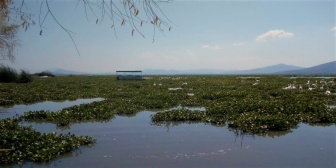Conagua asks to operate Guanajuato’s treatment plants against water lilies
News Category: News, Community News, and General Discussion
-
The head of the National Water Commission (Conagua) in Guanajuato, Vicente Zepeda López, pointed out that the wastewater treatment plants of the municipalities must be made to operate at one hundred percent of their capacity, as currently some only operate at forty or fifty percent, and this causes the appearance of water lilies in the aquifers.
“We have municipalities that discharge directly into the water vessels, in this case, Yuriria and San Miguel de Allende. In Yuriria, in the lagoon the proliferation of the aquatic lily is more due to the lack of wastewater treatment, we have treatment plants that are not working as they should work, they are working at forty or fifty percent,” he said.
“In the Allende dam, the wastewater discharges are practically the basis for the growth of the aquatic lily; besides, we have had two years with very scarce storage, the water that entered the dam was practically wastewater”, he commented.
Vicente Zepeda said that they have surveillance instruments and through inspection visits in the municipalities, they check if they are treating their wastewater.
“If it is negative, administrative procedures are carried out to the municipalities, they are economic sanctions ranging from 1,950 UMA (Unidad de Medida y Actualizacion) to 20 thousand,” he explained.

But he specified that sanctioning the municipalities is not the objective, but that his goal is to carry out in-depth actions that help the administrations to clean up their wastewater discharges through programs that the Conagua itself carries out year after year. “Any municipality can approach the Conagua every year, and they are informed about the programs they can access”, he said.
The official acknowledged that the lirio in the Yuriria Lagoon is a major problem, but there is a wastewater treatment plant in which the federal government invested, and today the problem is its operation, its maintenance, issues that correspond to the municipality and that are not being carried out.
“The municipal periods are very short, three years go very fast, while the municipality, the current administration is finding out how the situation is, when it sees, it is already finishing its term”, he criticized.

On the other hand, there is a lack of payment culture in terms of water treatment and sanitation by the population, “that could be a reason why the municipality does not have to operate the treatment plants,” he said.
Finally, Vicente Zepeda stressed that before making an investment to create a new water treatment plant, priority should be given to ensure that the existing plants are working properly.
“Year after year the Federation has resources to give to the municipalities for the improvement of their treatment, for the hydraulic network, the treatment plants, as long as they are based on projects that are well carried out and validated by the Conagua, both at a local and central level and being viable, they must be given continuity”.
-


Leave a Reply